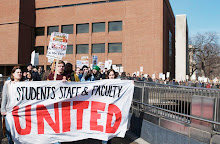***NOTE***page down to find posting for the text of FRPE's resolutions.
Dear Senators,
The president of the University proposes to declare a state of financial stringency. Accordingly, at a special meeting of the Faculty Senate called for March 25th, he will be asking senators to give their assent to a temporary reduction of faculty compensation in accord with Section 4.5 of the Regents’ Policy on Faculty Tenure:
4.5 Reduction Or Postponement of Compensation. If the University of a collegiate unit is faced with financial stringency that does not amount to a fiscal emergency, the president may propose a temporary reduction or postponement in compensation to be allocated to faculty in accordance with a mathematical formula or similar device. If approved by the Faculty Senate or the appropriate collegiate assembly, respectively, and the Board of Regents, the recurring salary of all faculty members in the University or in the designated collegiate units shall be reduced temporarily in accordance with the formula or device. The reduction may not continue for longer than two years, unless renewed by the same procedure.
This vote is part of a larger plan that affects the whole University, with similar pay cuts and furloughs proposed for all salaried employees of the University. Numerous faculty and staff have objected to the regressive flat rate structure of the proposed pay cuts, and to the lack of meaningful student, staff and faculty participation in determining how the budget shortfall should be addressed.
University of Minnesota faculty are privileged in having a strong tenure code that requires the administration to negotiate with us before cutting our pay. It is important that we exercise our role in University governance responsibly and work for a plan that preserves the University’s primary missions of education and research while protecting its most vulnerable workers. This requires access to information and a strong commitment to equity.
In this spirit, we offer two resolutions that will appear on the agenda for the special March 25th meeting. The first resolution, the Resolution on Financial Stringency, calls for the administration to provide faculty with complete information on expenditures and the relationship of these expenditures to the core mission of the University before asking faculty to give their assent to a temporary reduction of faculty compensation. The second, the Resolution on Salary Reductions, calls for the administration to introduce a sliding scale of pay cuts, should the need for pay cuts be demonstrated.
Resolution on Financial Stringency
The President has asked faculty to endorse his proposal to cut faculty salaries by 1.15 per cent. Given the threat budget cuts pose to the University’s core teaching and research missions, we believe that the discussion of faculty salary reductions needs to take place within the context of a wider discussion about budgetary priorities. Such a discussion requires full disclosure of the University’s budget, including a detailed account of all expenditures, as well as reductions already made or considered, that explains how each expenditure relates to the University’s primary missions of education and research. It requires further that the faculty have the opportunity to propose reductions other than those contemplated by the administration, and that the administration consider such proposals, justifying their adoption or rejection in terms of sustaining the University’s mission.
To date, the administration has only provided the Faculty Senate and the University community at large with information on decreases in revenue, increases in costs, and figures on savings projected to be achieved through its proposed reductions to employee compensation, without explaining how resources are expended or attempting to demonstrate that all reasonable reductions consistent with the University’s primary missions have already been made. The University currently spends millions of dollars on projects of questionable value to our core mission, including expenditures on controversial programs such as its Driven to Discover marketing campaign, its Wellness Initiative, and its proposal to develop UMore Park on the city’s suburban fringe. As has been reported in the media, administrative positions and costs at the University have also increased dramatically in the past decade. The administration must justify these expenditures before increasing tuition, imposing pay cuts, or laying off staff.
We do not contest that reductions in state funding have worsened the University’s present situation. But poor planning and misplaced priorities are also to blame, and further underline the need for budgetary transparency. Next year’s allocation is about the same as state funding in 2007. During the last two years, a hiring pause and salary freezes have been in effect. Academic units have already suffered painful cuts and numerous staff have been laid off. Given these cost cutting measures, with prudent administration, the University’s operating costs should not have increased so dramatically as to make a return to 2007 funding levels so catastrophic. Moreover, according to President Bruininks’s March 16, 2010 e-mail message to faculty, the present budget shortfall consists of the following three components: (1) increased annual costs, including a proposed 2% raise (44%); (2) the 27th pay period, a calendrical artifact of the bi-weekly payroll system (31%); (3) the governor’s proposed budget cut through unallotment (25%). The first and second components were not merely foreseeable but planned. Only the third, the governor’s unallotment, could be characterized as unforeseen.
The Regent’s Policy on Faculty Tenure gives faculty the power to insist on a transparent and inclusive approach to addressing the university’s current financial difficulties. The Resolution on Financial Stringency asks that the administration provide a detailed account of all current and projected University expenditures and savings, justifying each item and amount in terms of its relationship to the University’s primary missions of education and research. In addition, it requests an independent audit of the finances of the University, with a view to identifying areas where additional economies might be realized with minimal impact on the University’s primary missions. For a transparent budget process that protects the University’s core missions, we urge you to vote ‘yes’ on the Resolution on Financial Stringency, and ‘no’ on the president’s request for faculty to endorse pay-cuts.
Resolution on Salary Reductions
The administration has presented a plan for salary cuts that is projected to yield savings of $18.5 million. Savings will be achieved through the reduction of the salaries of all faculty and P&A employees by 1.15%, academic and administrative officers by 2.3%, and a three-day furlough for staff. We appreciate the administration’s revised proposal as an effort to respond to concerns faculty have expressed about equity in dealing with the University’s financial troubles. Nevertheless, the administration’s proposal of a uniform pay cut is inherently regressive in its disproportionate effect on lower-income members of the university community. A 1.15% pay cut (or three day furlough) represents a far greater portion of expendable income for someone earning $45,000, than it does for someone earning $200,000. Moreover, the 2.3% pay cut for academic and administrative officers is offset by the payment of the 27th pay period for those administrators on 12-month contracts and thus represents no cut at all (faculty on 9-month contracts do not benefit from the 27th pay period).
Should reduction of compensation be shown to be necessary, the Resolution on Salary Reductions seeks to distribute the burden of salary reductions in an equitable and progressive way while protecting employees who are the lowest paid and most vulnerable members of our community. There is a strong precedent for this. In a comparable period of economic duress in 1932, the Regents of the University of Minnesota imposed a salary cut on a sliding scale, reducing all salaries above a certain threshold and imposing no reduction on salaries below a certain threshold. According to a May 1932 news release by the University News Service,
“The regents put into effect a slash of 20% on that part of any salary over $3600; of 15% on that part between $2400 and $3600; of 10% on that part between $1100 and $2400, but left without reduction salaries and wages up to and including the figure$1200 [sic] a year.”
In 1932 the Regents demonstrated a strong commitment to equity and to protecting the most vulnerable staff at the University. The same principles should inform decisions today. The imposition of a sliding scale, down to zero for salaries below a certain threshold, would readily achieve or exceed savings projected to be achieved through the small reduction of faculty salaries currently proposed. In the Resolution on Salary Reductions we offer several examples for how this can be done. If our proposal is accepted, there would be no need to reduce salaries of the University’s lowest paid workers or to make deeper cuts to academic units.
Although the Faculty Senate can only approve or reject cuts to faculty salaries (i.e. not for other employees), by voting ‘yes’ to the Resolution on Salary Reductions we send a strong message to the university administration that a sliding scale cut should apply to all employees at the University.
What You Can Do on March 25th
On March 25th the Faculty Senate will be asked to give their assent to the president’s proposal for a reduction in compensation. We are bringing forth these resolutions in order to bring about a more transparent process for dealing with the university’s financial troubles that protects the university’s core mission and shelters its most vulnerable employees.
To demand a transparent and inclusive budget process that protects the university’s core mission, please vote ‘no’ to the president’s request and vote ‘yes’ on the Resolution on Financial Stringency.
To support a sliding-scale pay cut that protects the university’s most vulnerable employees, should a reduction in compensation be deemed necessary, please vote ‘yes’ to the Resolution on Salary Reductions.
Sincerely,
William Beeman, Professor and Chair, Department of Anthropology, College of Liberal Arts
Bruce Braun, Associate Professor, Department of Geography, College of Liberal Arts
William Messing, Professor, School of Mathematics, Institute of Technology
Steven Ostrow, Professor and Chair, Department of Art History, College of Liberal Arts
Karen-Sue Taussig, Associate Professor, Department of Anthropology, College of Liberal Arts
Tuesday, March 23, 2010
Subscribe to:
Post Comments (Atom)


No comments:
Post a Comment